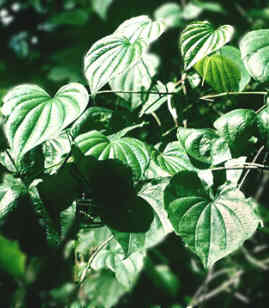
Plant Description
Caution & Interaction

Latin (botanical) name:
Dioscorea Villosa
Common names: Yam, Wild Yam, Dioscorea, Colic Root, Rheumatism Root, Wilde Yamwurzel
Plant Description: Wild Yam is a perennial, twining vine found in the United States in Florida, Texas, and north to Rhode Island and Minnesota. Its knotty, contorted, reddish-brown stem can grow as long as 18 feet. The slender, ligneous root-stock is twisted, crooked, and laterally branched. The leaves of the Wild Yam are ovate and cordate, 2-6 inches long, with a soft fuzz underneath the somewhat thick and glabrous upper surface. Around June and July, Wild Yam blooms with greenish-yellow flowers drooping in panacles. It's fruit is winged seeds encompassed by a capsule.
Medicinal Properties &Uses: Constituents of Wild Yam include aluminum, ascorbic acid, beta-carotene, calcium, dioscin, dioscorin, iron, magnesium, niacin, riboflavin, and zinc, just to name a few. It has been used for generations in the treatment of rheumatism and arthritis. Steroidal glycosides, or diosgenin, found in the root and anti-inflammatory properties that research has proven are the reason for Wild Yam's efficacy in these treatments. It is considered antispasmodic, diuretic, and expectorant, and is an excellent treatment for pains associated with urinary tract infections.
Dosage: 30-60 drops in water or juice, 2-3 times daily or as needed. Shake well before using.
Cautions & Interactions: Keep out of reach of children.
Efficacy Studies & Other Clinical Data: Helpful Links:
Disclaimer (U.S. Only): These statements have not been evaluated by the FDA. These products are not intended to diagnose, cure, treat, or prevent any disease.
Common names: Yam, Wild Yam, Dioscorea, Colic Root, Rheumatism Root, Wilde Yamwurzel
Plant Description: Wild Yam is a perennial, twining vine found in the United States in Florida, Texas, and north to Rhode Island and Minnesota. Its knotty, contorted, reddish-brown stem can grow as long as 18 feet. The slender, ligneous root-stock is twisted, crooked, and laterally branched. The leaves of the Wild Yam are ovate and cordate, 2-6 inches long, with a soft fuzz underneath the somewhat thick and glabrous upper surface. Around June and July, Wild Yam blooms with greenish-yellow flowers drooping in panacles. It's fruit is winged seeds encompassed by a capsule.
Medicinal Properties &Uses: Constituents of Wild Yam include aluminum, ascorbic acid, beta-carotene, calcium, dioscin, dioscorin, iron, magnesium, niacin, riboflavin, and zinc, just to name a few. It has been used for generations in the treatment of rheumatism and arthritis. Steroidal glycosides, or diosgenin, found in the root and anti-inflammatory properties that research has proven are the reason for Wild Yam's efficacy in these treatments. It is considered antispasmodic, diuretic, and expectorant, and is an excellent treatment for pains associated with urinary tract infections.
Dosage: 30-60 drops in water or juice, 2-3 times daily or as needed. Shake well before using.
Cautions & Interactions: Keep out of reach of children.
Efficacy Studies & Other Clinical Data: Helpful Links:
Disclaimer (U.S. Only): These statements have not been evaluated by the FDA. These products are not intended to diagnose, cure, treat, or prevent any disease.